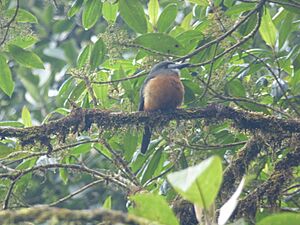White-faced nunbird facts for kids
Quick facts for kids White-faced nunbird |
|
|---|---|
 |
|
| Conservation status | |
| Scientific classification | |
| Genus: |
Hapaloptila
|
| Species: |
castanea
|
 |
|
The white-faced nunbird (Hapaloptila castanea) is a special kind of bird. It belongs to a family called Bucconidae, which includes puffbirds and nunlets. You can find this bird in the countries of Colombia, Ecuador, and Peru.
Contents
About the White-faced Nunbird
The white-faced nunbird is the only bird in its group, called a genus. Its scientific name is Hapaloptila. It does not have any different types, or subspecies. Sometimes people call it the white-face puffbird. This is because it is not a "true" nunbird, which belongs to a different group called Monasa.
What Does the White-faced Nunbird Look Like?
This bird is about 23 to 25 centimeters (9 to 10 inches) long. It weighs about 75 to 84 grams (2.6 to 3 ounces). It has a big white patch above its beak. This patch has a thin black line at the top.
Its head is gray-brown, and the sides of its face are dark brown. The rest of its top parts, including its wings and tail, are an even darker brown. Its chin and throat are white. The rest of its underside is a bright reddish-brown color. The beak is black, its eye is red, and its legs and feet are gray. Male and female nunbirds look very similar. The female might have slightly lighter reddish-brown feathers on her underside.
Where Do White-faced Nunbirds Live?
The white-faced nunbird lives on the eastern side of the Andes mountains. You can find it from western Colombia, through eastern Ecuador, and into northwestern and central Peru. It likes to live inside and at the edges of wet forests and cloudforests. These places often have steep hills and deep valleys.
You usually see these birds in the middle or upper parts of the trees. In Colombia and Ecuador, they live at high places, from about 1,500 to 2,900 meters (4,900 to 9,500 feet) high. Sometimes they are seen as low as 750 meters (2,500 feet). In Peru, they only live between 1,800 to 2,600 meters (5,900 to 8,500 feet) high.
How White-faced Nunbirds Behave
What Do White-faced Nunbirds Eat?
The white-faced nunbird mostly looks for food in the tops of trees. However, it can be active at all levels of the forest. It mainly eats insects and other small creatures with many legs, like spiders. It also eats some small animals with backbones. Sometimes, it joins groups of different bird species that are looking for food together.
White-faced Nunbird Reproduction and Life Cycle
We do not know everything about when white-faced nunbirds have their babies. But we do know they breed in April and May. One nest has been found and studied. It was a small room lined with leaves at the end of a 38-centimeter (15-inch) long tunnel. This tunnel was dug into a dirt bank.
The female bird lays two eggs. Both the male and female birds help dig the tunnel. They both sit on the eggs to keep them warm. They also both feed the young birds after they hatch.
What Sounds Do White-faced Nunbirds Make?
The white-faced nunbird's song is a series of single hoots. These hoots can go up or down in sound, or stay level. Sometimes they make double hoots, like a small owl. Their song can sometimes turn into a trill, or have rough, scraping sounds mixed in. They sometimes sing all day long, but they sing the most around sunrise.
Their calls include a sad, downward-sounding "wuooooo." They also make a series of barking sounds that start fast and then slow down. It sounds like "pah pah-pahpapapapa-pah-pah-grr?"
Conservation Status of the White-faced Nunbird
The IUCN (International Union for Conservation of Nature) has looked at the white-faced nunbird. They have decided it is a species of "Least Concern." This means it is not in danger of disappearing right now. Even though it lives in a small area, the number of these birds seems to be staying steady. It is considered rare to uncommon and is found in specific places. However, it lives in several protected areas, which helps keep it safe.


